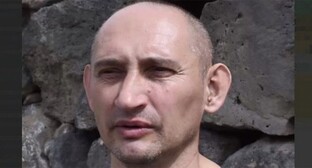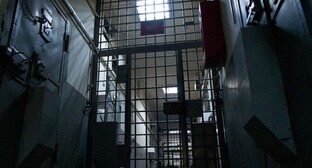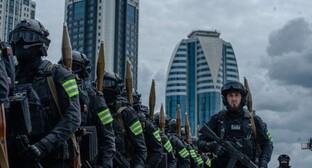26 May 2003, 16:00
Gelendzhik
Town in Krasnodar kray(region), kray subordination, 177 km south-west of Krasnodar, seaside climatic health resort of All-Russian significance. Located on the coast of Gelendzhik Bay of the Black Sea, surrounded by spurs of the Markotkh Ridge of the Greater Caucasus. Subtropical dry Mediterranean climate. Mild winter; cold winds, north-easters, sometimes blow from the dry land; temperature in January - February averages to 4?С. Spring is early and long; in mid-April, average daily temperature reaches 10?С. Summer is hot with a dry fair weather with some cloud; temperature in July averages to 24?С. Summer heat is softened by sea-breezes and rather low (up to 70%) relative humidity of the air. Autumn is warm. Average annual precipitation of about 800 mm, reaching its maximum from December to April. The climatic conditions most favourable for rest develop from June to September. The bathing season lasts from May to October, seawater temperature being 18 - 24?С.
Gelendzhik is 43 km south-east of the railway station of Novorossiysk (communication by bus and sea), on the Novorossiysk - Tbilisi - Baku highway. Population (1992 est.) 49.5 thousand, (1897 est.) 1.8 thousand, (1924 est.) 4.5 thousand, (1979 est.) 49 thousand.
The Black Sea coast near modern Gelendzhik has been populated since the most ancient times. 6 km south-east of Gelendzhik, there are remains of a Lower Palaeolithic settlement (about 200 thousand years old), which is the northernmost point of distribution area of Caucasian monuments dating back to the Acheulian time. Environs of Gelendzhik preserved remains of settlements of the bronze epoch and numerous structures of flag, dolmens (table-stones), dating back to the years 3 - 2 thousand BC). In the 6th century BC to the 3rd century AD, on the site of Gelendzhik, there was an antique settlement of Tyurik (Pagry; diggings revealed structures of the 6th - 5th centuries BC on Cape Tonky). Turkish port since the late 15th century. In the middle ages, this site of the Black Sea coast was inhabited by tribes of zikhs (zigs), then by their offsprings, Adygey tribes of the Natukhay and the Shapsug. The Adygey (Natukhay) name of the locality, Khulyzhy, means a small pasture (glade); probably, this name, borrowed by the Turks, acquired the form of Kelendchik (some researchers translated it from the Turkish as bride), and the Russians pronounce it as Gelendzhik. The Russian fortress of Gelendzhik was founded by General Y.A. Bergman in July 1831. During military colonisation of the Black Sea coast, it functioned as an important strong point of Russian troops and the base of ships of the Black Sea fleet. During the Crimean war of 1853 - 56, the fortress of Gelendzhik was blown up and left by its garrison (in March 1854) together with other fortifications of the Black Sea coast line. In 1857, Russian troops re-occupied the destroyed fortress. In 1864, the stanitsa (Cossack village) of Gelendzhikskaya within the Shapsug coastal battalion was founded here; after 1870, it was transferred to the civil department and transformed into a settlement. Gelendzhik obtained the town status in 1915. In the early 20th century, the population of Gelendzhik consisted primarily of peasant offsprings, who migrated from internal provinces of Russia, the Greeks and the Armenians, arriving from Turkey, as well as the Czech and the Moldavians.
As medical locality, Gelendzhik became a focus of attention in the late 19th century (after laying the Novorossiysk - Sokhumi highway). In 1901, a society of assistance to accomplishment of the Gelendzhik health resort was organised; in 1913, a sanatorium for children suffering from bone tuberculosis, was built. In 1917, Gelendzhik had several medical establishments, the number of beds totalling to 30 - 40; by 1941, the town had about 30 sanatoriums, providing rest and treatment for more than 60 thousand people a year.
During the Great Patriotic War of 1941-1945; Gelendzhik, similar to other health resorts of the Caucasian Black Sea coast, functioned as hospital centre. In winter 1942-1943, it was here that Soviet landing units were formed, who took part in fights in the Maly Zemlya (Small Land) and liberated Novorossiysk.
In 1990, the health resort of Gelendzhik operated 11 sanatoriums, including 5 trade-union ones (the number of beds totalling to about 4 thousand), 19 boarding houses and rest homes, 87 bases of rest. In the late 1980s and the early 1990s, they provided rest and treatment for about 1.5 million patients a year.
Alongside with the primary natural medical factor, climate (sea bathings, sunbaths), the health resort has mineral waters, which can be used for baths and peroral treatment. Supplied medical muds are also used (from Lake Solyonoye near Taman). Treatment of patients with diseases of cardiovascular, nervous and endocrine systems, organs of respiration and the locomotor system is carried out. A department of the Krasnodar branch of the Mikrokhirurgiya Glaza Interbranch Technological Complex (eye microsurgery) is open.
Gelendzhik is the centre of the Gelendzhik resort area of the Black Sea coast, which stretches for about 100 km and includes health resorts and resort localities: Kabardinka (to the north-west of Gelendzhik), Divnomorskoye, Dzhankhot, Betta, Krinitsa and Arkhipo-Osipovka (to the south-east of Gelendzhik).
Gelendzhik has enterprises of food-processing industry (a dairy factory, etc.), production of building materials, an integrated forest mill. There is the Research and Development Design Institute of Geophysical Ocean Prospecting Methods, the Southern branch of the P.P. Shirshov Institute of Oceanology (Russian Academy of Sciences).
Torikos Theatre. Museum of History and Local Lore (since 1909, expositions contain archaeological and ethnographic collections, etc.). Memorial house of the writer V.G. Korolenko (summer house in the eclectic style, 1902). Traditional holidays of opening of the resort season, carnivals are held.
The town is located on the long narrow seaside of Gelendzhik Bay, curving of which determines slightly rounded direction of streets in the town. In the 19th century, the town was built up under the regular town-planning scheme; in the late 19th and the early 20th centuries, with resort buildings in the styles of eclecticism and Art Nouveau. In the 1930 - 1980s, a school of arts, a harbour station, the Yantar shop, etc.
In the environs of Gelendzhik, there is a forest of Pitsunda pine (Pinus pithyusa), gardens and vineyards; medieval Adygey burial mounds, etc.




